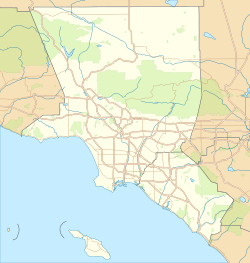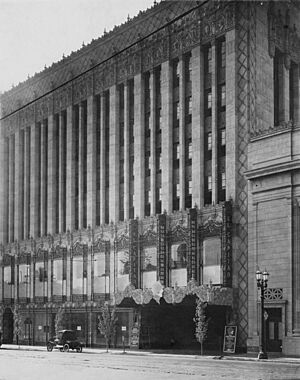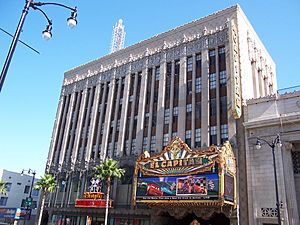El Capitan Theatre facts for kids
|
|

El Capitan Theatre on Hollywood Boulevard
|
|
| Address | 6838 Hollywood Boulevard Hollywood, California 90028 |
|---|---|
| Coordinates | 34°06′04″N 118°20′23″W / 34.101111°N 118.339722°W |
| Public transit | |
| Owner | The Walt Disney Company |
| Operator | Buena Vista Theatres, Inc. |
| Type | Movie palace |
| Capacity | 1,100 |
| Screens | 1 |
| Construction | |
| Opened | May 3, 1926 |
| Closed |
|
| Reopened |
|
| Architect | G. Albert Lansburgh Stiles O. Clements |
| Builder | Charles E. Toberman |
| Tenants | |
| Walt Disney Studios Motion Pictures | |
| Designated: | 1990 |
| Reference #: | 495 |
| Designated: | April 4, 1985 |
| Part of: | Hollywood Boulevard Commercial and Entertainment National Historic District |
| Reference #: | 85000704 |
El Capitan Theatre is a beautiful, old movie theater in Hollywood, California. It's like a grand palace for movies! The Walt Disney Company owns this theater and the building next to it, which is called the El Capitan Entertainment Centre. This special theater is where many new Disney movies have their first big showings, called premieres.
Contents
History of El Capitan Theatre
How El Capitan Began
In the early 1920s, a real estate developer named Charles E. Toberman had a big dream. He wanted to create a busy theater area in Hollywood. Toberman worked on many projects, including the Hollywood Roosevelt Hotel. He also helped open three famous theaters with Sid Grauman: the Egyptian (in 1922), El Capitan (in 1926), and the Chinese (in 1927).
El Capitan first opened on May 3, 1926. It was known as "Hollywood's First Home of Spoken Drama" because it showed live plays. For ten years, it hosted over 120 different shows. Famous actors like Clark Gable and Joan Fontaine performed there.
By the late 1930s, the theater faced tough times. It started showing fewer live plays. To attract more people, the management tried different kinds of entertainment. But business was still slow, so the theater began showing movies. In 1941, the famous movie Citizen Kane had its first showing at El Capitan. After this, the theater closed for a year because Paramount Pictures bought it.
Becoming the Hollywood Paramount
The theater was updated with a modern look. Its original fancy decorations were covered up, and the special box-seat balconies were removed. In 1942, the theater reopened as the Hollywood Paramount Theater. The first movie shown there was Cecil B. DeMille's Reap the Wild Wind.
The Hollywood Paramount was a very important theater for Paramount Pictures on the West Coast. But later, a court decision made the studio sell its theaters. After that, different companies managed the theater. By the 1980s, Pacific Theatres owned it.
Disney's Restoration and Reopening
In the late 1980s, Disney bought a part of one of Pacific Theatres' chains. This led to Disney's Buena Vista Theaters and Pacific working together. They decided to fix up the El Capitan Theatre and the Crest Theatre. They spent $14 million to completely restore the Paramount, bringing back its original look and its first name.
El Capitan reopened in 1991 with the premiere of The Rocketeer. The people who restored the theater even won an award in 1992 for their amazing work. In 1990, the city of Los Angeles named El Capitan a special historic monument.
After an earthquake in 1994, the building was damaged and flooded. It was considered unsafe. The owner left the theater, and it went to its mortgage company. Since Disney was still a tenant, the mortgage company spent $10 million to fix up the theater and the office floors above it.
In 1995, Disney rented the Hollywood Masonic Temple next door for a special event called "Totally Toy Story." This was like a mini theme park to promote the movie Toy Story. In 1998, Disney bought the convention hall to keep using it for promotions. A Disney Store also opened next to the theater in 1998.
More repairs were done in 1996 to make the building stronger against earthquakes. The full restoration of the building, including its tall sign tower, was finished in December 1997. In 2005, a new store called Disney's Soda Fountain and Studio Store opened on the ground floor.
In 2013, a Ghirardelli Soda Fountain and Chocolate Shop opened next to the theater, sharing space with the Disney Studio Store.
The theater temporarily closed in March 2020 because of the COVID-19 pandemic in California. It reopened a year later in 2021, but with fewer seats. The first movie shown after it reopened was Raya and the Last Dragon.
In 2023, Disneyland opened a new ride called Mickey & Minnie's Runaway Railway. The front of the ride looks like a movie theater called "El CapiTOON Theater," which is inspired by the El Capitan Theatre.
Features of El Capitan
The El Capitan Theatre is part of a six-story office building built in the 1920s. The outside of the theater looks like a fancy Spanish style, designed by Stiles O. Clements. The inside is a mix of styles. The main movie area looks like it's from East India, while the lower lobby has an English Tudor style. The front of the building has an Italian Baroque design.
The restored theater has a huge Wurlitzer theatre organ. This organ was first put in San Francisco's Fox Theatre in 1929. Below the theater, there's a small area where they often display cool props from movies, like costumes or parts of the sets. Right next door is Disney's Soda Fountain and Studio Store. Here, you can buy ice cream that matches the movie playing in the theater. They also have lots of Disney and movie-related items for sale.
Images for kids
See also
 In Spanish: El Capitan Theatre para niños
In Spanish: El Capitan Theatre para niños
- List of Los Angeles Historic-Cultural Monuments in Hollywood
- List of contributing properties in the Hollywood Boulevard Commercial and Entertainment District
- Hollywood Masonic Temple
- Grauman's Egyptian Theatre
- Grauman's Chinese Theatre









